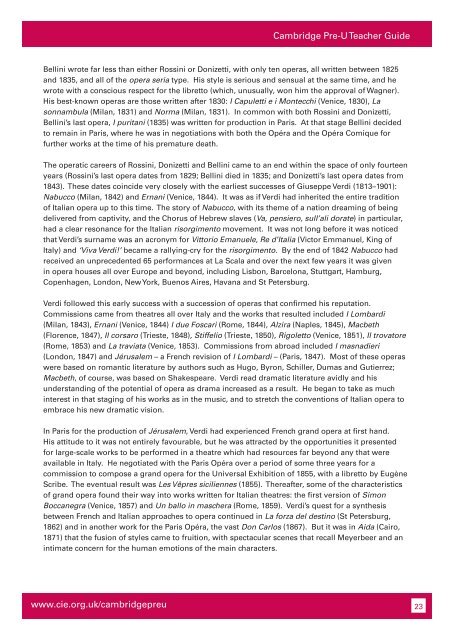Teacher's Guide Cambridge Pre-U MUSIC Available for teaching ...
Teacher's Guide Cambridge Pre-U MUSIC Available for teaching ...
Teacher's Guide Cambridge Pre-U MUSIC Available for teaching ...
You also want an ePaper? Increase the reach of your titles
YUMPU automatically turns print PDFs into web optimized ePapers that Google loves.
<strong>Cambridge</strong> <strong>Pre</strong>-U Teacher <strong>Guide</strong><br />
Bellini wrote far less than either Rossini or Donizetti, with only ten operas, all written between 1825<br />
and 1835, and all of the opera seria type. His style is serious and sensual at the same time, and he<br />
wrote with a conscious respect <strong>for</strong> the libretto (which, unusually, won him the approval of Wagner).<br />
His best-known operas are those written after 1830: I Capuletti e i Montecchi (Venice, 1830), La<br />
sonnambula (Milan, 1831) and Norma (Milan, 1831). In common with both Rossini and Donizetti,<br />
Bellini’s last opera, I puritani (1835) was written <strong>for</strong> production in Paris. At that stage Bellini decided<br />
to remain in Paris, where he was in negotiations with both the Opéra and the Opéra Comique <strong>for</strong><br />
further works at the time of his premature death.<br />
The operatic careers of Rossini, Donizetti and Bellini came to an end within the space of only fourteen<br />
years (Rossini’s last opera dates from 1829; Bellini died in 1835; and Donizetti’s last opera dates from<br />
1843). These dates coincide very closely with the earliest successes of Giuseppe Verdi (1813–1901):<br />
Nabucco (Milan, 1842) and Ernani (Venice, 1844). It was as if Verdi had inherited the entire tradition<br />
of Italian opera up to this time. The story of Nabucco, with its theme of a nation dreaming of being<br />
delivered from captivity, and the Chorus of Hebrew slaves (Va, pensiero, sull’ali dorate) in particular,<br />
had a clear resonance <strong>for</strong> the Italian risorgimento movement. It was not long be<strong>for</strong>e it was noticed<br />
that Verdi’s surname was an acronym <strong>for</strong> Vittorio Emanuele, Re d’Italia (Victor Emmanuel, King of<br />
Italy) and ‘Viva Verdi!’ became a rallying-cry <strong>for</strong> the risorgimento. By the end of 1842 Nabucco had<br />
received an unprecedented 65 per<strong>for</strong>mances at La Scala and over the next few years it was given<br />
in opera houses all over Europe and beyond, including Lisbon, Barcelona, Stuttgart, Hamburg,<br />
Copenhagen, London, New York, Buenos Aires, Havana and St Petersburg.<br />
Verdi followed this early success with a succession of operas that confirmed his reputation.<br />
Commissions came from theatres all over Italy and the works that resulted included I Lombardi<br />
(Milan, 1843), Ernani (Venice, 1844) I due Foscari (Rome, 1844), Alzira (Naples, 1845), Macbeth<br />
(Florence, 1847), Il corsaro (Trieste, 1848), Stiffelio (Trieste, 1850), Rigoletto (Venice, 1851), Il trovatore<br />
(Rome, 1853) and La traviata (Venice, 1853). Commissions from abroad included I masnadieri<br />
(London, 1847) and Jérusalem – a French revision of I Lombardi – (Paris, 1847). Most of these operas<br />
were based on romantic literature by authors such as Hugo, Byron, Schiller, Dumas and Gutierrez;<br />
Macbeth, of course, was based on Shakespeare. Verdi read dramatic literature avidly and his<br />
understanding of the potential of opera as drama increased as a result. He began to take as much<br />
interest in that staging of his works as in the music, and to stretch the conventions of Italian opera to<br />
embrace his new dramatic vision.<br />
In Paris <strong>for</strong> the production of Jérusalem, Verdi had experienced French grand opera at first hand.<br />
His attitude to it was not entirely favourable, but he was attracted by the opportunities it presented<br />
<strong>for</strong> large-scale works to be per<strong>for</strong>med in a theatre which had resources far beyond any that were<br />
available in Italy. He negotiated with the Paris Opéra over a period of some three years <strong>for</strong> a<br />
commission to compose a grand opera <strong>for</strong> the Universal Exhibition of 1855, with a libretto by Eugène<br />
Scribe. The eventual result was Les Vêpres siciliennes (1855). Thereafter, some of the characteristics<br />
of grand opera found their way into works written <strong>for</strong> Italian theatres: the first version of Simon<br />
Boccanegra (Venice, 1857) and Un ballo in maschera (Rome, 1859). Verdi’s quest <strong>for</strong> a synthesis<br />
between French and Italian approaches to opera continued in La <strong>for</strong>za del destino (St Petersburg,<br />
1862) and in another work <strong>for</strong> the Paris Opéra, the vast Don Carlos (1867). But it was in Aida (Cairo,<br />
1871) that the fusion of styles came to fruition, with spectacular scenes that recall Meyerbeer and an<br />
intimate concern <strong>for</strong> the human emotions of the main characters.<br />
www.cie.org.uk/cambridgepreu 23
















